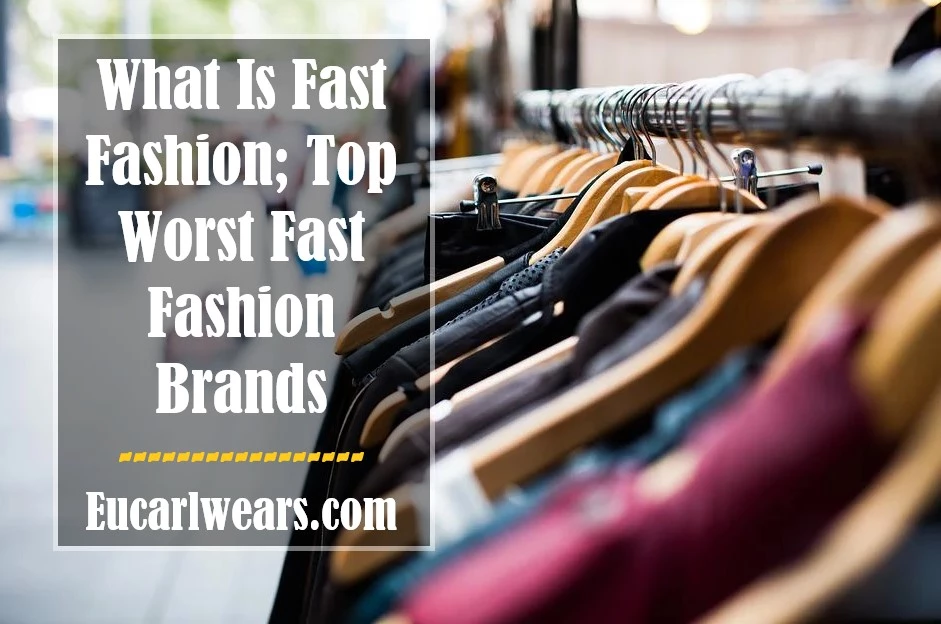What Is Fast Fashion; Top 20 Worst Fast Fashion Brands
Fast fashion is a tragic reality for the industry. It has major implications for the environment, planet, human resources, and animals. This is because fast fashion brands tend to exploit workers and increase the rate of clothing disposal, as the clothes wear out after a short period.
About 20 years ago, clothes shopping used to occur during seasons of the years, or when our old outfits were no longer up to size. Currently, this is no longer the order of the day. Online shopping sites and retail stores offer fast fashion, cheaper clothing, and trend cycles that are fast changing.
Clothes shopping which used to be an occasional event is now seen as a hobby. Anyone could afford trendy clothes with spare change, wear them a couple of times, and throw them away. You could spot a dress worn by your favorite celebrity in piles on the high street. The latest designs from catwalk shows hit the market at an outrageously low price.
The dark sides of fast fashion are worth exploring, so you can analyze how the fashion industry came to these terms, how it can be ended, and measures that can be taken. We would begin this fast fashion article by first having a clear picture of fast fashion clothing; what is fast fashion? Why is fast fashion so bad? Top fast fashion brands and environmental impacts of fast fashion.

What Is Fast Fashion?
Fast fashion in simple terms means any clothing business model which replicates the fashion wear of runway models at catwalk shows, and high fashion designs reproduce them in large quantities and with cheaper and low-quality materials. The mass production of these low-quality designs brings in high demand for those clothes but at very cheap costs. Fast fashion is cheap, trendy clothing produced by taking styles inspired by catwalk shows or celebrity styles couture.
Fast fashion clothing is those outfits that you buy and they seem to wear out and not last after some time. These garments are made available in retail stores and high street shopping centers at low prices to meet consumer demand.
The whole idea of fast fashion is to introduce fashion styles into the market as fast as possible. This way, the customers can shop for trendy outfits before the height of their popularity goes down. Unfortunately, shoppers would have to dispose of them after a few wears. This fashion style buys into the idea that repeating your outfits is a fashion faux pas and to stay relevant in the industry, you would have to dress in the latest looks. This leads to the overproduction of clothing and waste pollution.
History Of Fast Fashion
Fashion production used to be slow in the 1800s. Before any cloth was made, you would have to source wool or leather, weave them into fabrics, before making them into clothes that you could wear. This whole process was even slower without any technology. With the industrial revolution, sewing machines made clothes production quite easier and cheaper. There was also the establishment of dress-making stores that employed garment makers and home fabric workers.
The first disaster in a garment factory to be on record was a fire breakout in 1911 at the New York City Triangle Shirtwaist Factory. 146 garment workers died in the incident, most of which were female Immigrants. In the 1960s, new trends were fast gaining entrance into the market, but there was still a difference between haute couture and high street fashion.
Fast fashion came to be from the late 1900s to the 2000s. Fast-fashion brands occupied the high street and online stores to a peak. Brands like Zara, H&M, and Topshop took design elements from top fashion houses, replicated them in the shortest production times, and sold them out cheaply. Everyone is now able to shop for trendy clothes but in low fashion.
Elements Of Fast Fashion Brands
How to spot a fast fashion brand: These are elements that are key to the fast fashion process
- Price of garments and accessories: The low cost of clothing is one of the factors that are common to fast fashion brands. The clothes are made from low-quality materials like polyester which has microfibre shedding issues. Sometimes, these garments are claimed to be in limited quantities, to give the shoppers a sense of urgency.
- Methods and timeline of production: There is a short time between when the trend is spotted on catwalks or among celebrities and when it hits the shelves of clothing stores.
- Trend-based nature and disposability of the clothes: There are thousands of styles in most of the latest trends by these brands. The clothing is also suited for a few years before they are discarded.
Fast Fashion Sustainability
Fast Fashion wears are estimated on an average to last only for ten wearings
Pros of Fast Fashion
- Fast fashion stores offer clothes at very cheap and affordable rates
- Fast fashion overpopulates the market with high fashion and stylish clothing.
- The clothing industries where fast fashion wears are produced make more profits from production.
- Fast fashion brands contribute to sustainability
Cons of Fast Fashion
Why is fast fashion bad?
- Fashion is noted to be one of the largest pollutants in the world: Since fast fashion wear does not last for a long period, its disposal results in pollution.
Fast fashion waste is harmful to the environment and the planet. Corners are made in the systems of production, with the use of cheap chemicals and materials for cloth production, which ultimately pollutes the environment. Greenpeace has been making efforts through fashion campaigns, to stop supply chains and clothing brands from using dangerous chemicals.
Polyester is mostly used by fast fashion brands in clothing production. It is made from fossil fuels which can shed its microfibers, thereby increasing the plastic levels in the oceans, when they are washed. Even natural fabrics like cotton, when prepared for cloth production, requires the use of large amounts of water and pesticides, which can get into the water basins and resources.
- It promotes a disposal mentality of outfits in the minds of customers: With increased rates of clothing production, the turnover of waste products become increased. Wastes from cloth disposal, biodiversity, and chemical consumption during production, sum up to very harmful amounts to the environment.
Fast fashion can impact fashion buyers with a false impression that clothes that are no longer in trend should be disposed of and quickly replaced. Fast fashion causes us to spend and buy more clothes than we need.
- Workers in fast fashion industries and brands earn very low wages: To increase the rate of production, garment workers in fast fashion companies are made to go through horrendous work hours for low wages.
- Fast fashion brands harbor unsafe workplaces: Fast fashion workers are exploited and made to go through production in unfavorable conditions and atmospheres. This is impactful on both their physical and mental health.
- Some designers also claim that high street fashion lines steal their designs and give them out in mass production.
Fast Fashion Brands Online
The fast fashion big players include Zara and H&M
- H&M (Hennes and Mauritz): is the oldest fast fashion company and the most popular fast-fashion brand in the UK. This is one of the fast fashion giants to have started mass-production in 1947 in Sweden, before moving to London in 1976 and the United States in 2000.
- Zara: began their first fast fashion stores in Northern Spain in the mid-1970s. Zara extended their brands to New York in 1990 and was quickly identified as a fast-fashion brand.
Other Worst Fast Fashion Brands
The big names in fast fashion today are:
- Top Shop
- GAP
- UNIQLO
- Primark
Ultra-Fast Fashion Brands
These fast fashion companies are even cheaper and faster alternatives than contemporary fast fashion brands. They include:
- Boohoo
- Esprit
- Fashion Nova
- Forever 21
- Mango
- Missguided
- Nike
- Pretty Little Thing
- Rip Curl
- SHEIN
- Stradivarius
- Urban Outfitters
- Victoria’s Secret
- Zaful
Is Fast Fashion Going Green?
A growing number of retailers have introduced sustainable schemes, such as recycling initiatives, to make the use of fast fashion more ethical. It has been highlighted that these schemes have not been truly active since their introduction and are downright unproductive. The myriad of issues and massive pressures created by fast fashion on people and the environment construes that the whole system needs to be averted.
Is Fast Fashion Declining?
Though some changes have been spotted, they are still not enough to counter the mass-production of fast fashion brands.
Non Fast Fashion Brands
Slow fashion is the sustainable alternative to fast fashion. They embody slow and circular methods of wearing clothes.
Whimsy + Row
Organic Basics
Afends
Outland Denim
Yes Friends
studio JUX
Harvest & Mill
Conclusion: What Can We Do?
In conclusion, to avert the damages caused by fast fashion, choose high-quality clothes, buy fewer outfits, and make it last, by following the care instructions of the cloth or fabric. Asking ourselves some intentional questions like; Who made my outfit? and What are my clothes made of? can also be helpful measures towards this movement.


